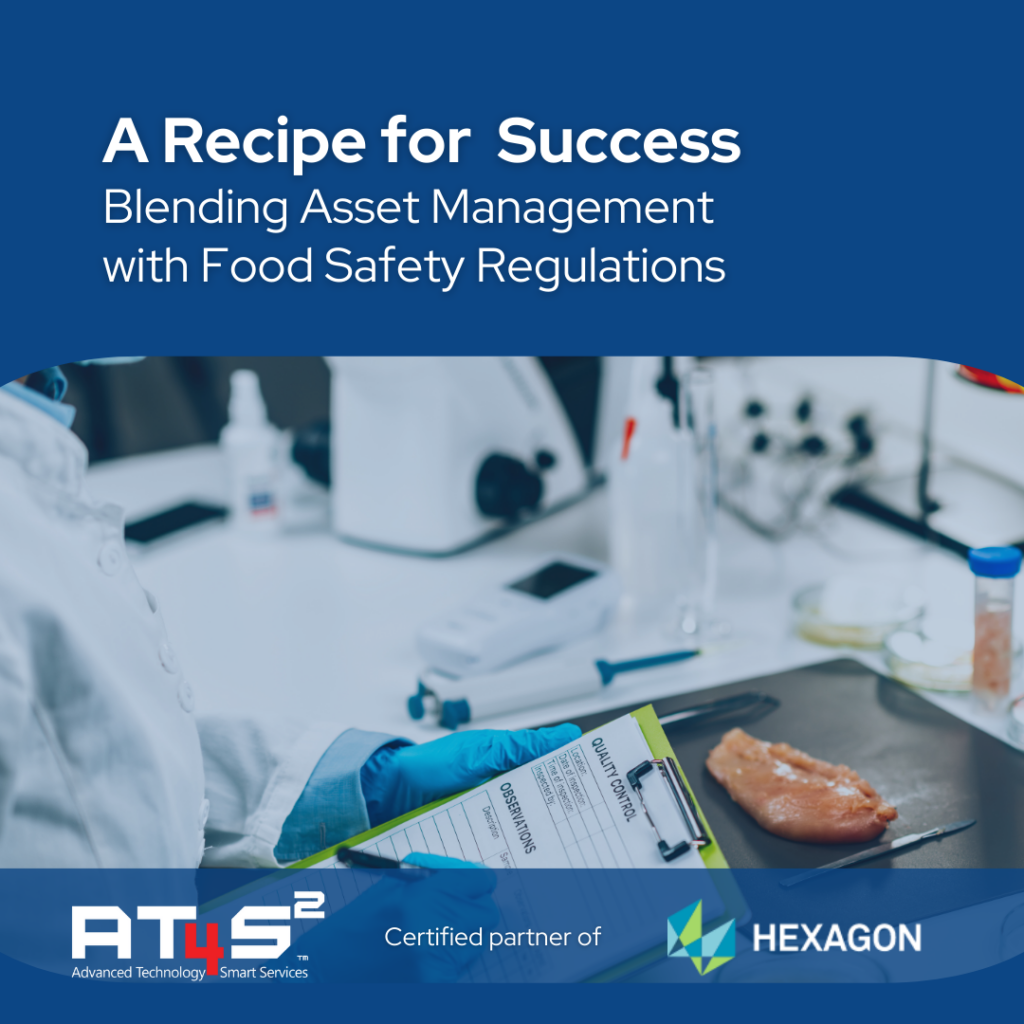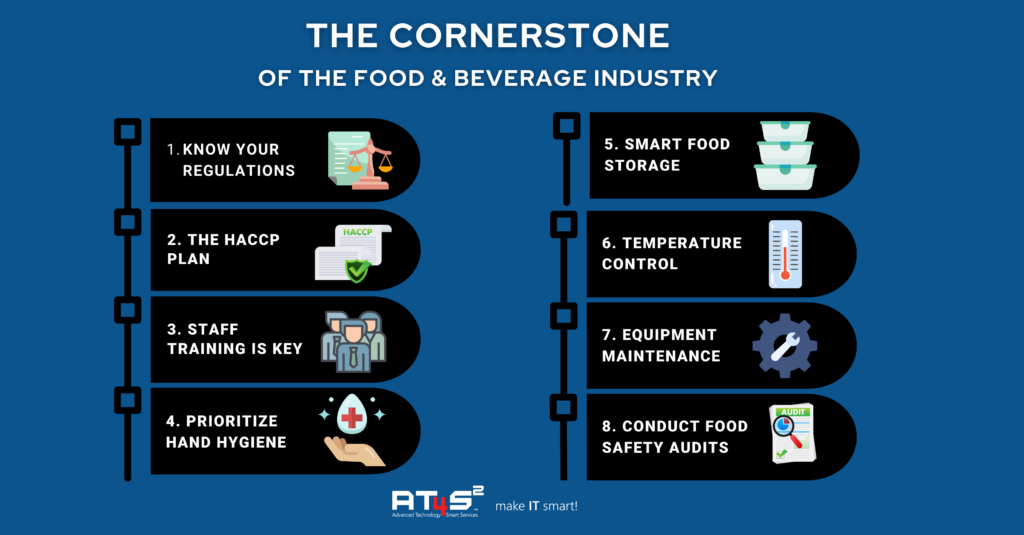A Recipe for Success – Blending Asset Management with Food Safety Regulations

7 February 2024
In the food industry, making sure a restaurant or producer complies with food safety regulations is akin to art as much as it is a science.
For businesses operating in food & beverage, the path to success is paved with challenges and opportunities alike. However, effective asset management, combining efficiency with regulatory compliance, transforms a daunting task into a competitive edge.
The Cornerstone of the Food & Beverage Industry
At the heart of the food industry lies a simple, undeniable truth: safety is paramount.
Food safety regulations stretch across every phase of food production, demanding meticulous attention to detail, as compliance is non-negotiable, a critical component of operational integrity and consumer trust.
Maintaining a sterling reputation and safeguarding customer health hinges on strict adherence to food safety and health regulations. As consumer awareness and regulatory demands intensify, businesses find themselves at the crossroads of compliance and operational efficiency. Let’s take a look at the essential steps:
- Know Your Regulations: The first step is foundational: understand the specific food safety and health regulations governing your region. This knowledge, encompassing guidelines from local health departments to national bodies, equips you to craft a robust compliance strategy.
- The HACCP Plan: A Hazard Analysis Critical Control Point (HACCP) plan is your strategic blueprint for identifying and mitigating potential hazards in food and beverage handling. This systematic approach ensures you’re not just reacting to issues but preventing them.
- Staff Training is Key: Comprehensive training for all staff members in hygiene, cross-contamination, temperature control, and personal hygiene is non-negotiable. It’s not a one-off but a continuous investment in your team’s competence and safety culture.
- Prioritize Hand Hygiene: Simple yet powerful, proper hand hygiene is a cornerstone of preventing foodborne illnesses. Regular handwashing and accessible sanitizing stations are simple practices with profound impacts on safety.
- Smart Food Storage: Proper food storage practices, like the first-in, first-out (FIFO) method, are critical in preventing bacterial growth and ensuring ingredient quality. For example, segregating raw meats from ready-to-eat foods avoids cross-contamination, keeping your offerings safe and fresh.
- Temperature Control: Regular monitoring of storage and food temperatures ensures that your ingredients remain within safe parameters, reducing the risk of spoilage and illness. Logbooks and digital monitors can aid in maintaining this vigilance.
- Equipment Maintenance: Operational kitchen equipment is essential for safe food preparation. A schedule for routine inspection and maintenance helps avoid unexpected breakdowns that could compromise food safety.
- Conduct Food Safety Audits: Regular internal audits provide a clear picture of where you stand regarding compliance and where improvements are needed. These proactive evaluations help you stay ahead of potential issues.

By embedding these practices into your daily operations, you can ensure your business will comply with existing regulations and is also ready to adapt to future changes. This proactive stance on food safety and health regulations not only protects your customers but also fortifies your establishment’s reputation in the competitive food and beverage industry.
The Role of Asset Management
Moreover, compliance with food safety and health regulations goes beyond being a legal requirement, as it is a promise to consumers that their well-being is a top priority.
And asset management can be the catalyst to ensure that all regulatory aspects are taken well care of. This strategic approach – besides serving as an effective inventory keeping system – can be the conductor ensuring that every piece of equipment, every process, and every hand involved in production operates at peak efficiency and compliance. Let’s see how asset management orchestrates safety and quality exactly:
Maintenance & Calibration
Imagine a concert pianist about to perform on a grand piano. Before the first note resonates, the piano is meticulously tuned to perfection. Similarly, in food production, regular maintenance and calibration of processing equipment are essential.
This diligence prevents contamination, ensuring that food production produces a safe, regulation-compliant output. Asset management ensures that equipment is not just functional but performing optimally, reducing the risk of safety breaches.
A More Traceable, Transparent Supply Chain
Asset management turns the supply chain into an open book.
On the one hand, this transparency bolsters recall readiness, where pinpointing the source of a potential issue becomes a breeze, but on the other it also reinforces consumer confidence – a critical currency in today’s market. Consumers want to know where their food comes from and how it’s handled.
Asset management provides the answers by tracking every step of the journey from farm to table.
Quality Control
Effective asset management also ensures that the quality of products remains unwavering, so that it can be the testament to a company’s commitment to excellence.
With a robust asset management system, you can guarantee that each product adheres to the highest quality standards. Consistency not only satisfies your consumers’ taste buds but also fosters trust and loyalty.
Training the Staff to Become Guardians
An often-overlooked asset in the food production process is human capital. Ensuring that staff are well-trained in compliance and safety procedures is crucial.
Well-trained employees become guardians of quality and safety, actively contributing to the success of the production. And in this role, asset management – while focusing on equipment primarily – also helps teach and enhance the skills and knowledge of the workforce.
All in all, asset management fine-tunes equipment, traces the journey of ingredients, maintains unwavering quality, and transforms employees into skilled guardians of food safety. While ensuring compliance, it creates a symphony of safety and excellence that resonates with both regulators and consumers. So, the next time you savor a delicious meal, remember that behind every bite lies the meticulous orchestration of asset management, dedicated to your and your customers’ well-being.
Ensuring Compliance Together
AT4 Smart Services is at the forefront of integrating asset management solutions tailored for the food and beverage industry. Our suite of services is designed not just to simplify compliance but to turn it into a lever for operational excellence. With our help in adapting HxGN EAM and training the workforce to operate it optimally, businesses can confidently navigate the complexities of food safety regulations, ensuring they not only comply but lead in their industry.
Are you ready to transform your operations?
Discover how our asset management solutions can empower your operations, making food safety compliance a seamless part of your success story.
